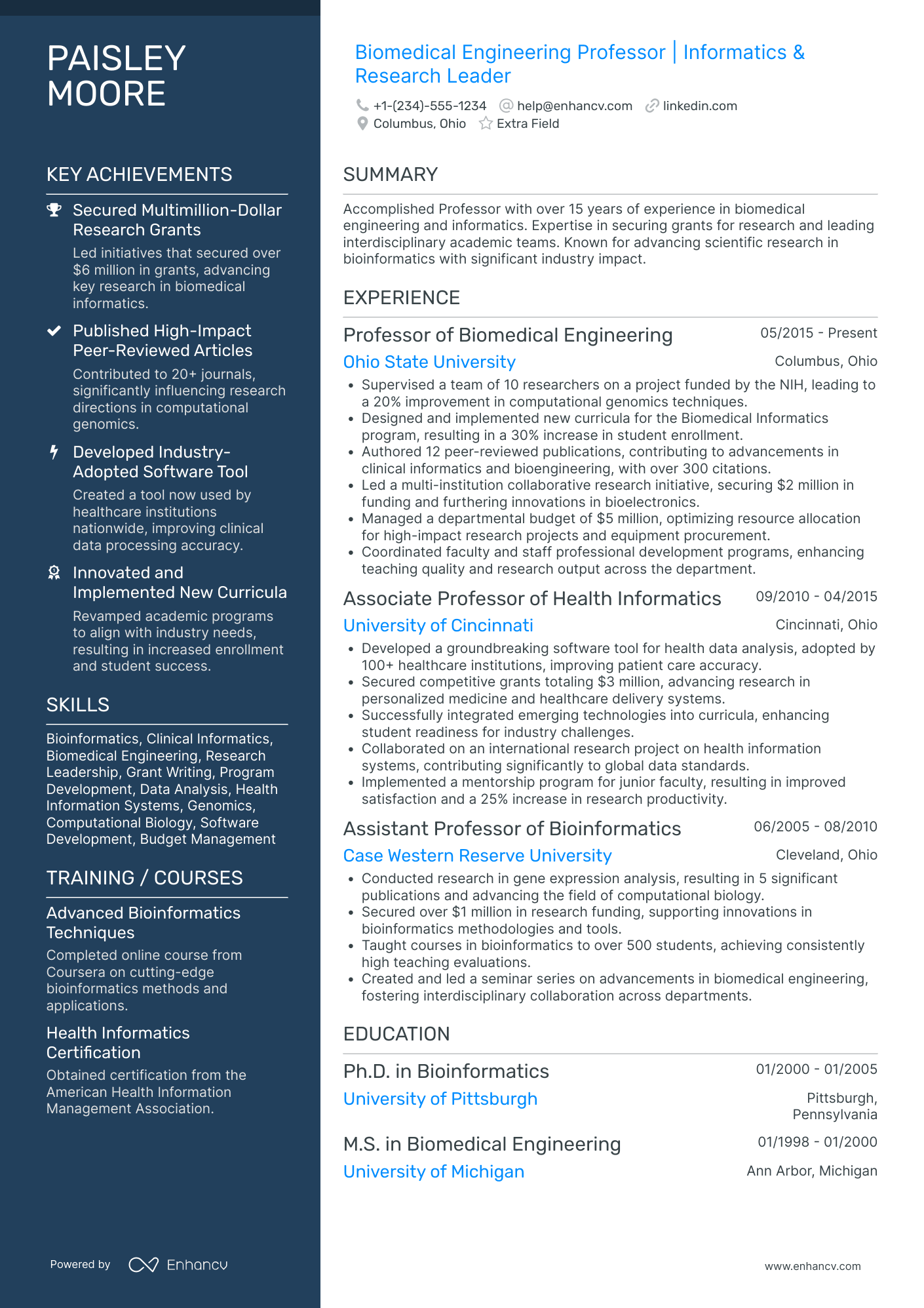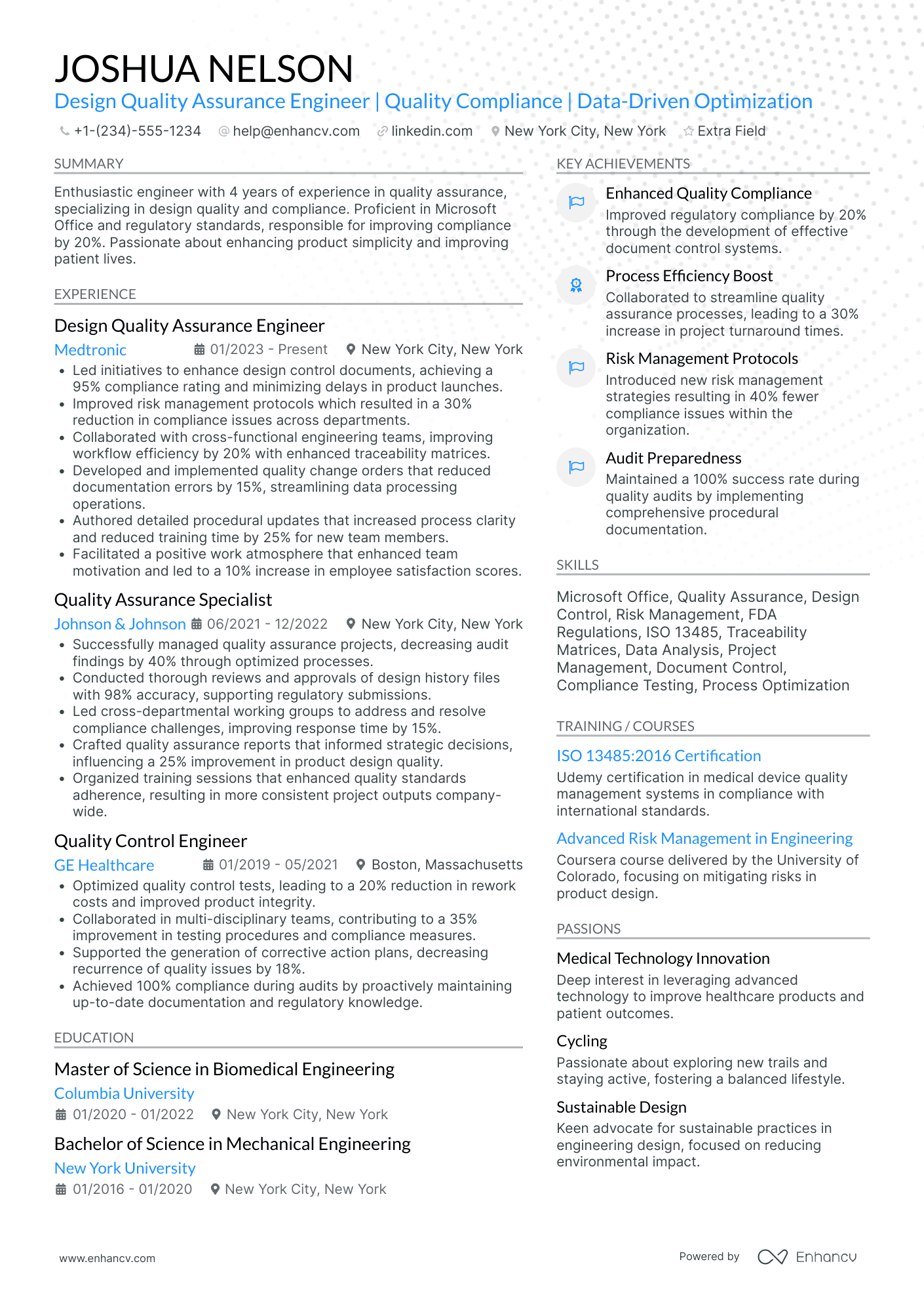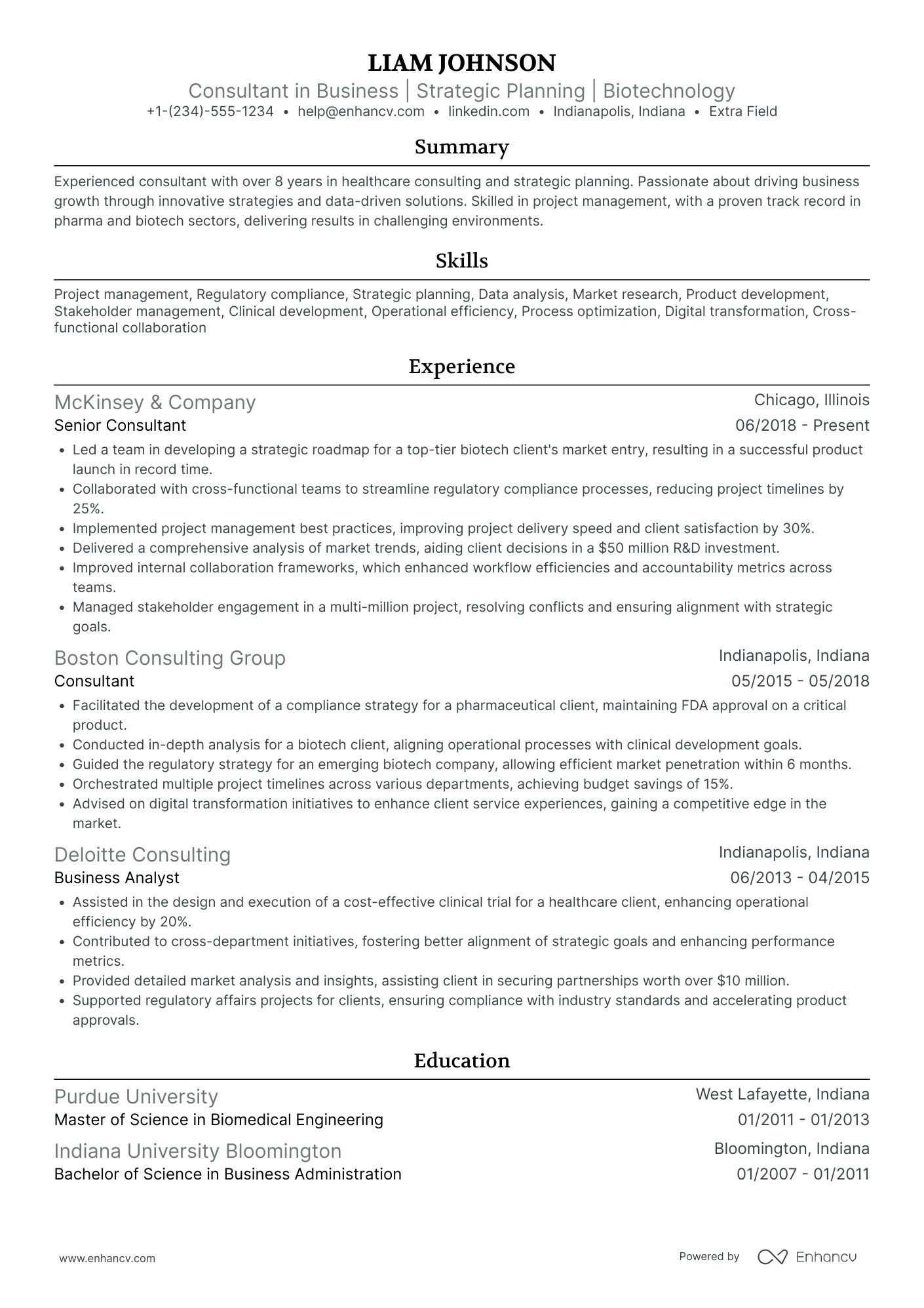You just landed on a job posting for an open biomedical engineering position at your dream company.
They are one of the global leaders in medtech and the healthcare industry.
Joining their team would be an excellent opportunity for you, skyrocketing your career as a biomedical engineer.
Not only would you be designing medical equipment that can potentially save millions of lives, but you’ll also be working with a prestigious team of engineers that you admire.
Getting hired would be a dream come true.
But first you need to wow them with the perfect resume that proves you’re the top candidate.
You may have all the requirements they’re looking for, but you need to display them with a resume that stands out from the pool of other applicants.
We’re here to help you get hired.
This step-by-step guide will teach you exactly what you need to know to write a job-winning biomedical engineering resume.
Here’s what you will learn.
Our biomedical engineer resume guide will teach you:
- How to highlight your biomedical engineering expertise
- Why using quantitative data will set you apart from other candidates
- 8+ ideas to show your duties as a biomedical engineer
- 36+ examples of technical and soft skills to get you started in the right direction
Looking for related resumes?
- Mechanical Engineer
- Systems Engineer
- Manufacturing Engineer
- Entry Level Mechanical Engineer
- Chemical Engineer
Top tips for writing a biomedical engineer resume
biomedical engineering is a rewarding career path, but it requires determination and unwavering passion to succeed.
Hiring managers are looking for candidates that have both the technical and soft skills needed to do a great job.
Your biomedical engineering resume must display your:
- Ability to work well with a team
- Enthusiasm and passion for the industry
- Qualifications, experience and knowledge of the technical aspects
Companies need to ensure they’re hiring the right biomedical engineer for the role since there’s high stakes in your work. The medical devices you will help engineer will directly impact many people.
Now, what is the best resume format to show you’re right for the job?
Highlight your expertise most effectively with a reverse chronological resume format.
Hiring managers will emphasize your experience and skill-set the most when reviewing your resume, and the reverse chronological format does just that.
The reverse chronological resume also allows you to:
- Discuss your education & qualifications
- Write a clear and concise summary
- Personalize to the specific job you’re applying for
Here's what a recruiter will look for in your resume
- Have you designed and improved medical equipment before? In what capacity?
- Do you have a Bachelor’s or Master’s degree in biomedical engineering?
- Have you collaborated with a team before and produced positive results?
- Are you a generalist or do you specialize in a specific area of biomedical engineering?
Answering these questions will help the hiring manager decide if they want to invite you for an interview. It all begins with a striking resume header.
Writing a descriptive header for your biomedical engineer resume
The resume header is the simplest part of your resume, but it’s your first opportunity to make a lasting impression.
Let’s say you’re applying to a medtech company that’s a global provider for advanced medical equipment.
Here’s a basic header that doesn’t go the extra mile:
This example has the essentials: name, location, title and email - it won’t stand out in a pile of resumes.
You can boost the quality of your resume header by adding some extras:
- A more descriptive title that highlights your seniority level
- Important links where recruiters can go for more information (ie. LinkedIn)
With just a few extra lines, this header goes from just okay to great. It lists the seniority level of the applicant (Sr. Biomedical engineer), and includes a link to their LinkedIn profile for more context.
Using real numbers is key on a biomedical engineer resume
What else takes a biomedical engineer resume from basic to outstanding?
Job-winning resumes have real quantitative data to highlight success in former roles.
Ask yourself these questions:
- How many medical devices did you design and produce?
- What was your performance rating? Use percentages to make your point.
- Did you have a low warranty return rate? Use real numbers to shine light on this point!
This data strengthens your resume summary and experience sections.
Let’s talk about how to write a strong biomedical engineer resume summary.
How to write a strong biomedical engineer professional summary
The summary section of your biomedical engineer resume has two goals:
- To summarize in a clear and concise way who you are and why you’re qualified for the role
- To show your genuine interest in the specific job you’re applying for
The hiring manager will first look to see if you have the right level of experience for the role.
Check the job description to see how many years of experience are required, and specify how many years you have in your summary.
You also should note if you specialize in a certain area of biomedical engineering.
For example, you may specialize in engineering new surgical instruments, or on the contrary, you specialize in telehealth.
If you’re applying for a biomedical engineering job in a certain specialization, you should list your experience with that specialization in your summary.
To display your genuine interest in the specific job you’re applying for, mirror the same keywords they use in the job description to your professional summary.
Not only will this indicate that you’ve done your research for the role, but it will help your resume get past applicant tracking systems that screen for keyword matches.
Here are two examples of a biomedical engineer professional summary.
The first one needs a bit of work, and we’ll tell you why. The second summary is an excellent example to take inspiration from.
This summary is too vague to make an impact. It doesn’t paint a picture about what makes the candidate right for the role.
Here’s an example of an excellent biomedical engineer summary:
This biomedical engineering summary checks all the boxes:
- Details information about the candidate’s experience level
- Highlights both their technical and soft skills
- Mentions their area of expertise
- Demonstrates their passion for the specific job role
Pro tip
Read the job description closely and mirror the same keywords they use in your own professional summary.
Optimize your resume summary and objective for ATS
Drop your resume here or choose a file.
PDF & DOCX only. Max 2MB file size.
How to write about your biomedical engineer experience on your resume
The experience section of your biomedical engineering resume will be one of the most important, so take your time getting this section right.
Each experience blurb should accomplish two goals:
- Discuss your role and responsibilities on the job
- Describe the positive impact you made (with quantitative data)
As with the summary section before, taking note of the keywords used in the job posting will help you craft a personalized resume.
Check out the responsibilities of the job role you’re applying for, and mirror that same language in the descriptions of your experience blurbs.
For example, does the job role say you will need to extract data using a specialized program? If you have experience doing that exact task in a former role, mention it directly!
Do you need to have a strong understanding of molecular modelling and visualization software, such as Maestro or Chimera?
Those are perfect talking points for your experience descriptions.
As a biomedical engineer, your knowledge of computer software is essential information for the hiring manager.
Note down how and when you have used a certain program to prove your proficiency.
Aside from your software and technical knowledge, soft skills, like being good at working in a team and writing technical documents, will set you apart from other candidates.
Most applicants focus only on their technical skills in their resume skill section, underestimating how essential soft skills are in biomedical engineering.
Putting your best foot forward and demonstrating in the experience section that you’re a well-rounded candidate will improve your chances of landing an interview.
We have a huge list of technical and soft skills you can include in your resume later on in this guide.
To get you started in the right direction, we found two examples of biomedical engineering resumes for you.
The first one needs more work, and we’ll tell you why. The second example covers all the bases.
2 biomedical engineer resume experience samples
- •Designed and improved medical equipment
- •Cut repair costs
- •Trained doctors on how to use medical equipment
- •Ensured patient and staff safety
This example is uninteresting. The listed responsibilities are vague and don’t say anything about the impact the candidate made in their former role.
Here’s an example that’s more likely to get you an interview.
- •Worked with a team of 35+ engineers to construct devices for computer-aided surgery
- •Boosted team efficiency by 40% by improving techniques for instrument testing
- •Proficient in Maestro for modelling and visualization
- •Adhered to Safe Medical Device Act (SMDA) & Good Manufacturing Practice (GMP)
- •Achieved an average performance rating of 99%
This is more like it.
This candidate uses qualitative data to support their points, mentions specific software they’re proficient in, and highlights their soft skills - such as being able to work effectively with a large team.
How to describe the duties of a biomedical engineer on a resume
Here are some examples of biomedical engineer responsibilities you can pick and choose from to add to your resume:
- Designed and improved medical equipment
- Designed programs to test medical equipment
- Developed user interfaces to display signals in devices
- Serviced hospital medical equipment
- Presented technical documents to support findings
- Create devices for computer-aided surgery
- Engineered safety alerts for medical equipment
- Maintained health and safety standards
What’s essential for the biomedical engineer education section?
Hiring managers look for highly-educated candidates when hiring a new biomedical engineer.
Since they place a big weight on education, it’s essential that you nail the education section of your resume.
Having a Master’s degree in biomedical engineering will improve your chances of getting hired, however, some entry-level positions will accept a B.S. degree too.
Indicate on your resume what level of education you have required and what degree you have.
What skills do employers look for in a biomedical engineer resume?
Technical proficiency in your specialty of biomedical engineering should form the basis of your skills section.
Biomedical engineering spans across many disciplines, so tailor your resume for the skill-set that you have.
Again, this is another great instance where you should mirror the same keywords used in the job description in your list of skills (but only if you genuinely are proficient in them).
Hiring managers are also looking for well-rounded candidates who have a mix of technical and soft skills.
Soft skills set you apart from other biomedical engineers.
You use your technical skills to build revolutionary medical devices.
You discover opportunities for improvement and communicate those findings to other professionals in the medical field, putting your soft skills to use.
Here are a list of 36 technical and soft skills you can choose from to get you started in the right direction.
25 technical skills to include on a biomedical engineer resume
- Electrosurgery devices
- Anesthesia machines
- Telemetry systems
- Bio-medical signal processors
- ISO 9001 Standards
- MATLAB
- Tissue engineering
- Biomaterials
- Neural engineering
- Biomechanics
- Telehealth
- Biosignal processing
- Medical imaging
- Computational modelling
- Bioinstrumentation
- Clinical engineering
- Orthopedic bioengineering
- Rehabilitation engineering
- Systems physiology
- Visual Sonics 2D Echocardiographic Strain Imaging Software
- CAD
- Safe Medical Device Act (SMDA)
- Good Manufacturing Practice (GMP)
- LabVIEW
- Patient Monitoring Systems and Devices
11 soft skills to include on a biomedical engineer resume
- Presentation skills
- Compliance with regulations & standards
- Communication skills (written & spoken)
- Writing technical documentation
- Team collaboration
- Client liaison
- Budget management
- Mathematical and analytical skills
- Time management
- Research
- Problem solving & troubleshooting
Designing any kind of biomedical device is a long, extensive project that involves a lot of people, and being able to work well in a team. To understand people from different disciplines is critically important.
Andrew McCulloch, Distinguished Prof. of Bioengineering and Medicine at theUniversity of California, San Diego
Summary: what are the top tips for the best biomedical engineer resume?
- Include quantitative data in your resume to prove your biomedical engineering impact
- Highlight your specialty as a biomedical engineer, from building electrosurgery devices to building solutions in telehealth
- List the software programs you’re most familiar with using, such as Maestro or Chimera
- Highlight your mix of technical and soft skills to show you’re a well-rounded biomedical engineer
Biomedical Engineer resume examples
By Experience
Junior Biomedical Engineer
Senior Biomedical Engineer
Biomedical Engineering Intern
Biomedical Engineering Director
By Role




































